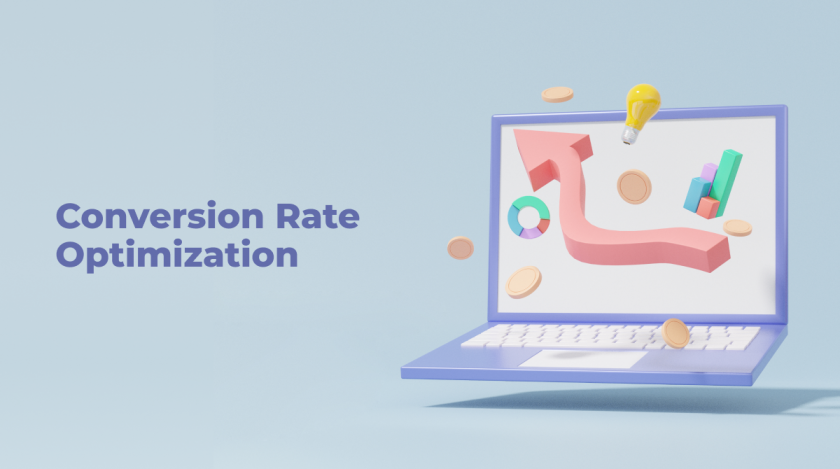Markedly, eCommerce conversion rate optimization is essential for your business. It helps you understand your customers better while analyzing their journey through the website, lowers customer acquisition costs, and draws more leads. It also increases the lifetime value of the buyer.
By providing a smooth experience, your revenue increases, and instead of one-time buyers, you get loyal customers and advocates that resonate with your brand’s philosophy.
So, what’s this CRO? How to optimize your eCommerce website for higher conversions? We’ll cover all of this in this article.
What Is eCommerce Conversion Rate Optimization?
The eCommerce CRO or conversion rate optimization is improving your website to make visitors perform desirable actions: add a product to a wishlist or cart, subscribe to your newsletter, and make a purchase. It involves lots of activities, including:
- Optimizing your product pages for easy, intuitive purchases.
- Streamlining the checkout process.
- Optimizing your blog for queries relevant to your target audience.
- Adding a human element to the website, being more conversational.
- Using popups (wisely), etc.
With a smart CRO strategy, your business will generate more leads and customers.
What Is a Good eCommerce Conversion Rate?
There’s no blanket answer to this question since a “good” conversion rate depends on:
- your niche;
- the age and authority of your business;
- the type(s) of marketing campaigns you run.
Nowadays, the food and beverage sector has the highest conversion rate, 4%, while the home furniture sector has the lowest one – only 0.7%. Haircare and health & beauty are also some of the highest-converting industries, generating 3.2% and 3.1% respectively.
An example of convenient high-conversion product pages is Amazon, with each online store using the “buy now” trick.
It eliminates several steps, like adding the product to the cart, clicking on it, and proceeding to checkout. This trick helps people make fast decisions and place orders easily.
This is good for both the user experience of your website and your revenue.
Another feature with similar purposes is cart preview.
It helps you remember what you’ve already added to the cart, thus improving usability and decreasing the chances of you forgetting all about it and closing the tab.
Factors That Affect eCommerce CRO
Some factors can improve or destroy your eCommerce CRO. To increase engagement and improve conversion, the following have to be on-point:
- Targeting the right audience – there’s no sense in targeting everybody. Analyze your potential buyers’ persona and target those groups. They are much easier to convert into active buyers than those unfamiliar with the niche.
- Great first impression – the first seconds of interaction with your website will decide everything. Make sure the pages load fast, the content is clear and well-structured, and you have high-quality media content so that people can visually “touch” your product.
- Relevant content – how-to’s, FAQs, expert posts, statistics, case studies, infographics, etc. – must all be related to your business niche. The content should also be optimized for relevant keywords your target audience uses.
- Clear CTAs – sometimes people need a nudge to leave their contact information or make a purchase. Make it easier for them with smart calls-to-action always in sight.
- Easy checkout – simpler is better, so ensure the checkout process doesn’t consist of 25 steps. Make it as easy as possible, asking only for essential information.
- Website speed – use PageSpeed Insights to see how well your site performs according to Core Web Vitals and how fast it loads. Strive for the result of fewer than two seconds.
- Website structure and navigation – using breadcrumbs and having a clear interface and navigation is essential for a positive user experience and conversion.
Tools to Measure Conversion Rate
Here are some tools you can use to measure the conversion rate and see if your eCommerce CRO efforts are working:
- Google Analytics.
Google Analytics is the first tool to turn to if you need to see your conversions. In the Conversions section, there’s a separate eCommerce section. Enable it and add a tracking code to your pages to see data on conversions. - Google Tag Manager.
In addition to GA, Google Tag Manager allows you to create transaction events and triggers, amplifying the data Google Analytics provides on your eCommerce conversion rate. - SE Ranking.
You can use Google Rank Checker of SE Ranking to monitor the organic rankings of your keywords. The tool will show you data for any location or device and all popular search engines. You can also research Google Ads rankings, SERP Features, and Google Maps data for local SEO. - Hotjar.
Hotjar allows you to follow users’ actions on your website. You can see how people navigate your pages to place CTAs and interaction elements properly.
Keep an eye on the pages with high keyword rankings and lots of traffic that don’t work well on conversion. There must be something off with them, and they should be in the first queue for CRO.
8 Ways to Increase Your eCommerce Conversion Rate
These eight ways are proven techniques for conversion rate optimization for eCommerce. Use some or all of them to optimize your website for a higher level of engagement.
#1: Work on Your UX
User experience means a lot for conversion. It’s important to understand how users interact with your website and make it more convenient and intuitive for them. Namely, you should work on the interface, navigation, loading speed, and CTAs.
There’s a three-click rule that states a visitor should be able to find all the needed information in 3 clicks. While it’s a controversial rule, and you should focus on building for experience, not the number of clicks, making your website easier to navigate is crucial.
If it’s an eCommerce website, the Homepage > Category > Subcategory > Product page is an acceptable template. Don’t make it too difficult to find your products.
Adding an internal search engine is also a good practice if you sell a wide range of products.
#2: Understand the customer journey
Go through the customer journey as if you were a regular Internet user. Take all the steps and look at them with a critical mind. What makes a person stumble along the process? Maybe it’s annoying pop-ups, or maybe there are too many steps, each asking for more information in a way that seems suspicious.
You can also reverse engineer the journey from the confirmation page to the homepage. Find ways to make the process smoother and, as you implement changes, do the whole process over again.
#3: Improve key pages
The key pages for your eCommerce CRO are product pages and landings. These should have a clear message about the benefits of your products and how they are better than the competitors’.
Here are some tricks for eCommerce pages:
Have at least two sections under the product’s description – order and return and sizing.
To avoid overcrowding the page, hide the contents under links.
Also, it’s a good idea to make reviews as accessible as possible.
Here, you can see the overall rating ratio and separate categories of reviews with images and keywords.
Other tricks for eCommerce websites:
- Address users’ concerns about the features of the products, return policy, money-back guarantee, etc.
- Write compelling descriptions that provide information and make people think they need the product.
- Offer concise messaging on landing pages without vague words.
- Create a sense of urgency by writing about limited availability or a special offer lasting only 10, 12, 24, etc., hours.
- Use pricing offers to encourage people to purchase without hesitation.
#4: Engage the audience
For eCommerce conversion rate optimization, you can engage the audience by using:
- UGC – user-generated content will create social proof and give you more than just a review; it’s a sign that your customers are your advocates.
- Visuals – for better description and engagement, use images and videos. They can be educational or entertaining and should lead people into the context of your brand. Use infographics, screenshots, graphics, and videos to diversify the content.
- Real cases – seeing real examples of people benefiting from your product will encourage others to buy it. Before/After series can persuade a user to become a buyer.
Work on your written content, optimize it for the right keywords and keep its readability in mind: no complicated terms, no vague words, and no large paragraphs without subheadings or lists.
#5: Simplify the checkout process
To increase the conversion rate for eCommerce, make the checkout process simple. Allow access to website guests without creating an account, although you can encourage them to create one to track their orders and get additional information.
Also, keep the number of steps to a minimum. You don’t need too much information to complete an order. Get an email to notify about order status and use it for email marketing, where you can gather necessary information later.
#6: Use remarketing
If you want to increase eCommerce conversion to the max, use remarketing. By tracking abandoned carts, for example, you can retarget your ads and landing pages to those people who abandoned them, encouraging them to finish their purchases.
This is especially convenient if, during the first steps of the funnel, the user gives you their email. By sending them several follow-up emails reminding them about the products they have in their carts, you increase the chance of them completing the transaction.
You can send emails with customer reviews and/or a small discount to slightly nudge the user to buy what they have chosen.
#7: Conduct A/B testing
Conduct A/B tests for landing pages and the checkout page. See which landing works best for improving conversions and optimize the other ones for the same template. Talking about checkout, make it a one-page checkout without obligatory registration. Make sure nothing distracts the user, where the only two ways they can go are:
- Completing the checkout.
- Going back to the cart.
Test several templates and, through A/B testing, find the perfect one.
#8: Simplify order returns
We know you don’t want people to return your products, but these things happen in every business. So, to make the lives of your customers easier when they are trying to return your product and to avoid negative reviews about your company, simplify the process as much as you can.
Have the information about ordering, delivery, and return under a link on product pages and in the footer of each page for easier accessibility.
Summary
Conversion rate optimization for eCommerce involves lots of processes, including:
- Working on the user experience of your website.
- Looking into the customer journey.
- Optimizing the key pages is important for conversion.
- Engaging people to keep them on the website, persuading them to take the focus action.
- Making purchases and returns easier.
- Using remarketing.
- Conducting A/B testing to see what works for your eCommerce CRO.
Use these approaches and monitor results regularly to find a perfect SEO combination for conversion rate improvement. Also, check out the trends to see the optimal conversion in your industry to ensure you have realistic expectations. Use digital tools to track results, get recommendations, and never stop improving! Buyer behavior has its trends and fluctuations. If you know these trends and are fluent in search engine optimization, your eCommerce conversion rates will always be high. Feel free to check the collection of the best conversion-friendly Shopify themes.















